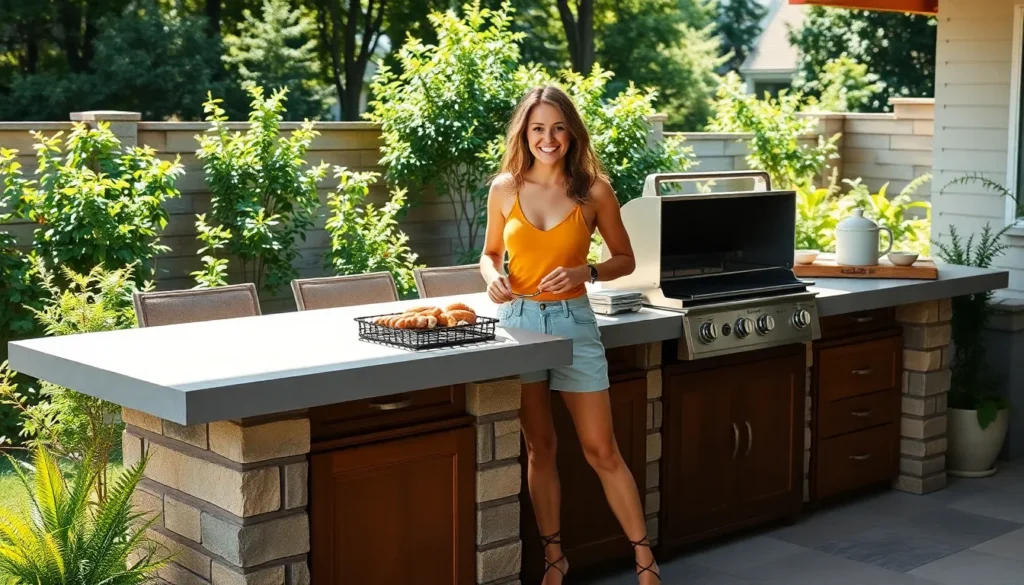Transform your outdoor cooking space into the ultimate backyard oasis with the perfect BBQ island countertop. We’ve discovered that choosing the right surface material can make or break your outdoor kitchen experience – it’s not just about looks but durability, maintenance, and functionality too.
Whether you’re grilling weekend burgers or hosting elaborate dinner parties, your countertop needs to withstand scorching heat, sudden temperature changes, and constant use. We’ll explore premium options like natural stone, concrete, and tile that deliver both stunning aesthetics and practical performance.
The right countertop doesn’t just complete your BBQ island – it elevates your entire outdoor entertaining game. From budget-friendly answers to luxury installations, we’re here to guide you through materials, styles, and design considerations that’ll have your neighbors asking for your secret to outdoor kitchen perfection.
Natural Stone Countertops for Timeless Elegance
Natural stone brings unmatched sophistication to outdoor kitchens while delivering exceptional performance. We’ve found that stone surfaces create stunning focal points that elevate any BBQ island design.
Granite Options for Heat Resistance and Durability
Granite stands as our top recommendation for high performance outdoor cooking spaces. This igneous rock withstands temperatures up to 1,200°F without cracking or discoloration, making it ideal for areas near grills and pizza ovens. Popular varieties like Black Galaxy, Uba Tuba, and Kashmir White offer distinct patterns that complement various design styles.
Maintenance requirements remain minimal with granite surfaces requiring only periodic sealing every 1-2 years. The stone’s dense composition resists staining from marinades, oils, and acidic foods that commonly spill during outdoor cooking. Installation costs typically range from $40-80 per square foot including fabrication and professional mounting.
Durability benefits extend beyond heat resistance as granite handles heavy cookware, cutting boards, and frequent cleaning without showing wear patterns. We recommend choosing darker granite colors for BBQ islands since they hide minor scratches and maintain their appearance longer than lighter alternatives.
Marble Surfaces for Luxury Appeal
Marble transforms ordinary outdoor kitchens into elegant entertaining spaces with its distinctive veining patterns. Carrara, Calacatta, and Statuario varieties showcase beautiful white backgrounds with gray veining that creates visual interest. The natural cooling properties of marble make it excellent for pastry preparation and drink service areas.
Installation requires professional expertise due to marble’s weight and specialized cutting requirements. Costs typically range from $50-100 per square foot depending on the exact variety and thickness selected. Honed finishes work better than polished surfaces in outdoor environments as they provide better slip resistance and hide etching marks.
Sealing becomes crucial with marble countertops as the stone’s porous nature makes it susceptible to staining from oils and acidic substances. We recommend applying high quality sealers every 6-12 months to maintain protection. Regular cleaning with pH neutral products helps preserve the stone’s natural beauty and prevents permanent damage.
Travertine and Limestone for Rustic Charm
Travertine offers a naturally textured surface that complements Mediterranean and rustic outdoor kitchen designs. The stone’s characteristic holes and pitted surface create authentic old industry appeal while providing excellent slip resistance when wet. Popular colors include ivory, walnut, and gold that blend seamlessly with natural landscaping elements.
Limestone presents a more uniform appearance with subtle color variations that range from cream to gray tones. Both stones cost significantly less than granite or marble, typically ranging from $20-40 per square foot installed. The softer composition makes these materials easier to cut and shape for custom applications around curved islands or integrated features.
Weather resistance varies between different stone types with denser varieties performing better in freeze thaw cycles. We suggest selecting stones with lower absorption rates for outdoor applications and applying penetrating sealers annually. Regular cleaning prevents buildup of organic materials that can cause staining or promote algae growth in humid climates.
Concrete Countertops for Modern Industrial Style
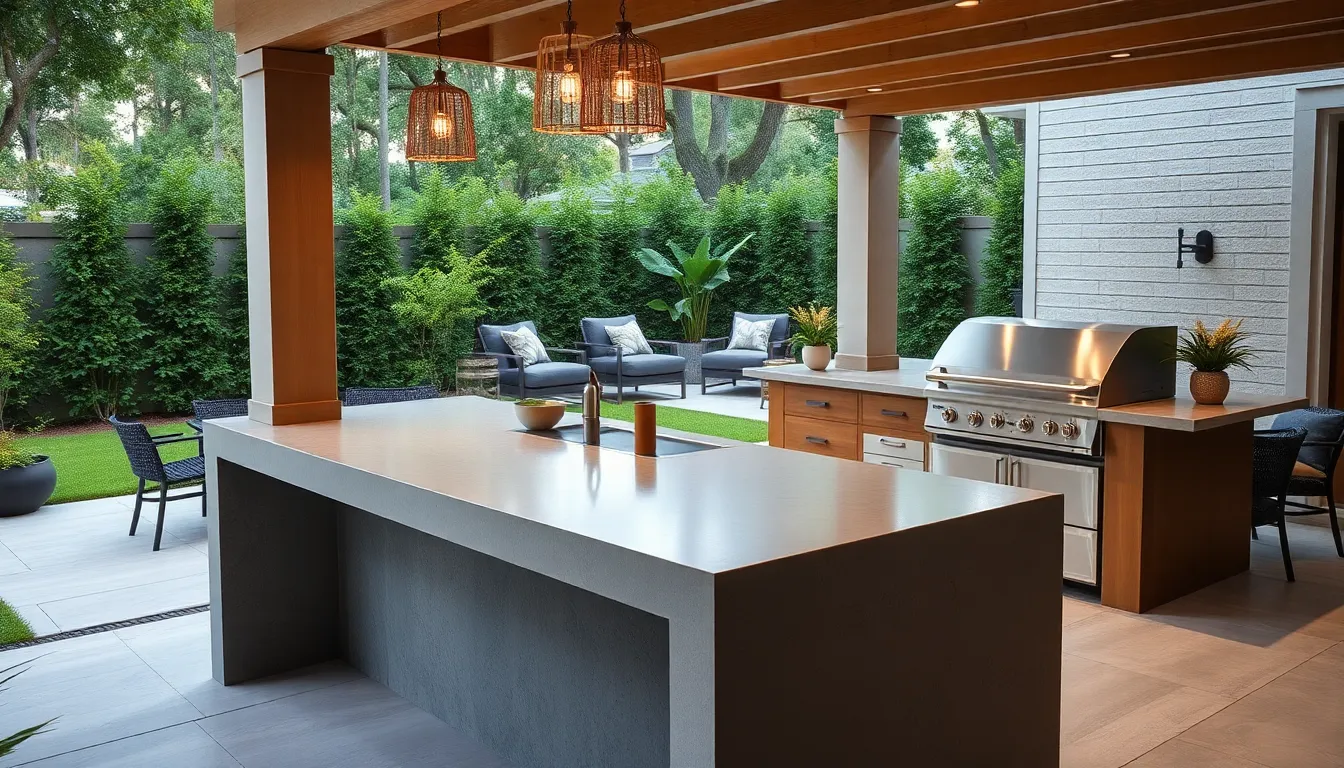
Concrete countertops bring a raw, minimalist aesthetic to your BBQ island that perfectly captures the modern industrial style. We’ve found that the natural gray tone and clean lines of concrete create a robust foundation that complements outdoor kitchens seeking both durability and contemporary appeal.
Polished Concrete for Sleek Contemporary Look
Polished concrete transforms your BBQ island into a sophisticated outdoor cooking space with its smooth, reflective surface. We recommend this finish for homeowners who want the industrial appeal of concrete but prefer a more refined appearance. The polishing process creates a shiny surface that’s easier to clean and maintain than rough concrete, making it ideal for frequent outdoor entertaining.
Benefits of polished concrete include enhanced durability and stain resistance compared to standard concrete finishes. The reflective quality adds visual depth to your outdoor kitchen while maintaining the structural integrity concrete is known for.
Stamped and Textured Concrete Designs
Stamping techniques allow us to create concrete countertops that mimic natural materials like stone, brick, or wood without sacrificing concrete’s inherent durability. We can incorporate various textures and patterns during the stamping process to add visual interest and complement your existing outdoor decor.
Textured concrete surfaces offer several advantages including better slip resistance and the ability to hide minor imperfections. Decorative elements such as hand seeded glass, acid stains, or embedded aggregates can be incorporated to further personalize your BBQ island design.
Integrated Concrete Features and Custom Shapes
Custom concrete countertops excel at seamlessly integrating with your BBQ island’s exact layout and appliance requirements. We can create pour in place installations that form directly on your island frame, allowing for seamless edges and customized overhangs of approximately 1.5 inches for optimal grill placement.
Built in features like appliance cutouts, integrated sinks, and custom drainage channels can be incorporated during the forming process. Both precast and pour in place methods are available for DIY enthusiasts, making concrete countertops an accessible option for outdoor kitchen projects of various skill levels.
Stainless Steel Surfaces for Professional Kitchen Appeal
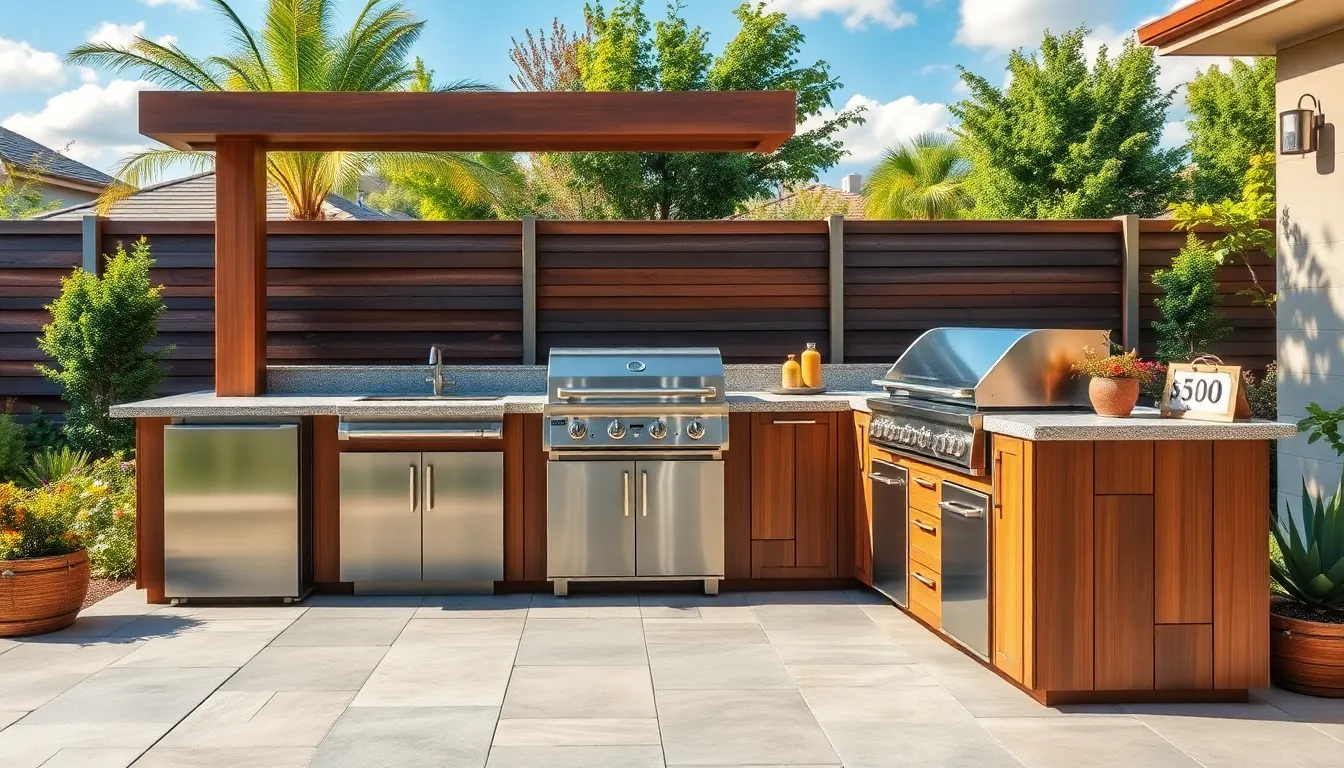
Restaurant-grade 304 stainless steel brings that coveted commercial kitchen aesthetic directly to your outdoor BBQ island. The brushed finish creates a sleek, modern appearance that transforms any backyard cooking space into a professional-grade culinary environment.
Commercial-Grade Stainless Steel Benefits
Durability stands as the primary advantage of commercial-grade stainless steel countertops, offering long-term resistance to corrosion and rust in all weather conditions. Weather-resistant properties ensure these surfaces endure harsh outdoor elements season after season without compromising their structural integrity.
NSF Certified food safety standards make stainless steel countertops the hygienic choice for outdoor food preparation areas. Built to withstand the demanding requirements of professional kitchens, these surfaces integrate seamlessly with commercial-grade outdoor appliances and cabinet systems.
Compatibility with various island configurations enhances design flexibility, whether you’re planning L-shaped or U-shaped layouts. Custom setups accommodate wine coolers, bar fridges, and multi-cabinet arrangements that suit both functional and aesthetic outdoor kitchen designs.
Maintenance and Cleaning Considerations
Easy cleanup distinguishes stainless steel from porous stone surfaces, requiring only regular wiping with mild cleaners to maintain pristine appearance. Smooth, non-porous surfaces prevent bacterial buildup, improving overall kitchen hygiene without risk of damage or staining.
Corrosion-resistant nature eliminates maintenance concerns related to weather damage or rust formation. Unlike natural stone materials that require periodic sealing, stainless steel maintains its protective properties without additional treatments or specialized care routines.
Regular maintenance involves simple daily cleaning practices that preserve the professional appearance. Grease and food residue wipe away effortlessly, making post-cooking cleanup quick and efficient for busy outdoor entertaining.
Integration with Outdoor Kitchen Appliances
Compatibility with various outdoor kitchen modules facilitates complete customization of your BBQ island design. Standard cabinet sizes integrate perfectly with stainless steel surfaces, creating cohesive layouts that maximize both storage and workspace functionality.
Heat and grease resistance supports appliance longevity in demanding BBQ cooking environments. The material’s thermal properties complement high-temperature cooking equipment while maintaining structural stability during intense grilling sessions.
Multi-appliance configurations benefit from stainless steel’s versatile mounting capabilities, accommodating everything from built-in grills to side burners and warming drawers. Seamless transitions between appliances and countertop surfaces create professional-grade cooking zones that rival indoor commercial kitchens.
Tile Countertops for Versatile Design Options
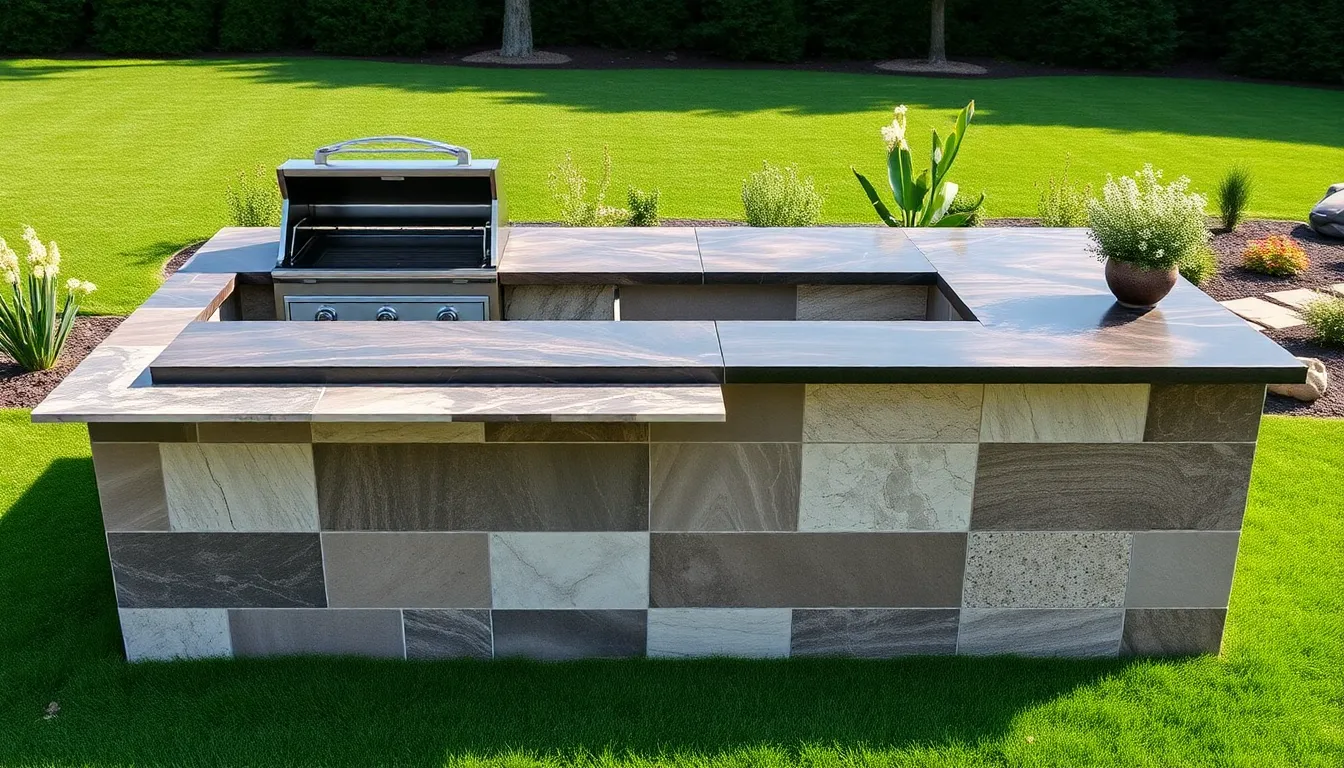
Tile countertops bring exceptional flexibility to outdoor BBQ island designs while delivering the durability needed for year-round outdoor use. We find that tile surfaces offer endless customization possibilities through various materials, colors, and patterns that can complement any backyard aesthetic.
Ceramic and Porcelain Tile Choices
Ceramic tiles provide an affordable foundation for BBQ island countertops with impressive heat and moisture resistance properties. We recommend these tiles for homeowners seeking reliable performance without breaking the budget, as they withstand outdoor conditions exceptionally well.
Porcelain tiles excel in outdoor applications due to their denser composition and lower porosity compared to ceramic options. We observe that porcelain’s superior weather resistance makes it the preferred choice for areas experiencing harsh seasonal changes or heavy rainfall.
Design versatility stands out as porcelain and ceramic tiles’ greatest advantage, offering countless colors, finishes, and textures. We can achieve everything from sleek modern looks with large format tiles to rustic charm with textured surfaces that mimic natural materials.
Installation flexibility allows us to create custom patterns and incorporate decorative borders that enhance the overall BBQ island design. We appreciate how these tiles accommodate curved edges and complex island shapes without requiring specialized cutting techniques.
Natural Stone Tile Applications
Granite tiles deliver exceptional heat resistance, withstanding temperatures up to 1,200°F without damage or discoloration. We choose granite for areas directly adjacent to grills where extreme heat exposure occurs regularly, ensuring long-term performance and safety.
Slate tiles offer rugged durability with natural slip resistance that’s perfect for outdoor environments. We find that slate’s naturally textured surface provides excellent grip even when wet, making it ideal for poolside BBQ islands or areas prone to splashing.
Travertine tiles create timeless elegance with their distinctive pitted texture and warm earth tones. We recommend travertine for homeowners wanting a Mediterranean or rustic aesthetic, though proper sealing remains essential for weather protection.
Stone tile maintenance requires periodic sealing to prevent stains and weather damage, but the investment pays off through decades of reliable service. We advise clients that this minimal upkeep preserves the natural beauty and structural integrity of their stone surfaces.
Mosaic Tile Patterns for Visual Interest
Mosaic patterns transform ordinary BBQ island countertops into stunning focal points through creative combinations of shapes, colors, and materials. We design custom mosaics that reflect each homeowner’s personal style while maintaining the functional requirements of outdoor cooking spaces.
Artistic flair emerges when we blend different tile materials like glass, stone, and ceramic within single mosaic designs. We create visual depth and texture that draws attention and becomes a conversation piece during outdoor gatherings.
Geometric patterns using mosaic tiles can define exact zones within larger BBQ islands, such as prep areas versus serving spaces. We strategically place these patterns to guide traffic flow and create visual organization in multi-functional outdoor kitchens.
Color coordination between mosaic accents and surrounding industry elements helps integrate BBQ islands seamlessly into existing backyard designs. We select tile combinations that complement outdoor furniture, plant materials, and architectural features for cohesive outdoor living spaces.
Quartzite Countertops for Superior Durability

Quartzite represents one of our most recommended natural stone options for BBQ island countertops. This metamorphic stone forms under intense heat and pressure, creating an exceptionally hard surface that outperforms many traditional materials.
Heat and Weather Resistance Properties
Quartzite excels in high-temperature environments, withstanding heat up to 1,000°F without sustaining damage to the stone itself. This impressive heat tolerance allows you to place hot grilling tools and cookware directly on the surface during busy cooking sessions. But, we recommend using trivets or hot pads to protect the sealant coating, which can experience damage when exposed to extreme heat for extended periods.
Weather resistance makes quartzite particularly suitable for outdoor applications where countertops face constant exposure to elements. The stone’s natural toughness helps it resist environmental wear from rain, sun, and temperature fluctuations. Proper sealing becomes essential to maintain protection from moisture penetration and potential staining in outdoor settings.
Color and Pattern Variations Available
Design flexibility ranks among quartzite’s strongest advantages for custom BBQ island projects. We find clients appreciate the wide spectrum of available colors, from subtle cream and beige tones to dramatic grays and whites. Natural veining patterns create visual interest that can mimic marble’s elegant appearance while providing superior durability.
Bold veining options allow you to create striking focal points within your outdoor kitchen design. Softer neutral patterns complement various décor themes, from contemporary minimalist styles to rustic outdoor entertaining spaces. Each quartzite slab offers unique characteristics, ensuring your BBQ island countertop becomes a one of a kind design element.
Maintenance Requirements and Longevity
Periodic sealing protects quartzite countertops from stains and moisture penetration due to the stone’s natural composition. We recommend professional sealing every 12 to 18 months for outdoor installations to maintain optimal protection. Regular cleaning with mild detergents keeps the surface looking pristine without requiring harsh chemicals that could damage the stone or sealant.
Long term durability makes quartzite an excellent investment for BBQ island countertops, with properly maintained surfaces lasting decades without replacement. The stone’s resistance to scratches and wear ensures it maintains its appearance even with frequent use during outdoor cooking and entertaining. Compared to granite, quartzite’s less porous nature reduces bacterial growth risk and makes cleanup easier after messy grilling sessions.
Brick and Masonry Surfaces for Rustic Character

Brick and masonry surfaces bring authentic rustic charm to outdoor cooking spaces while delivering exceptional durability. These time-tested materials create the perfect foundation for BBQ islands that can withstand high heat and harsh weather conditions.
Traditional Brick Countertop Construction
Building a brick countertop requires careful planning and precise execution to ensure long-lasting results. We recommend starting with a concrete footing that extends at least twice the width of your planned island, positioned at or just below ground level to provide maximum stability.
Foundation work becomes even more critical in cold climates where frost can cause structural damage. The footing should extend below the frost line to prevent shifting and cracking during freeze-thaw cycles. This extra depth investment protects your entire BBQ island investment for decades to come.
Laying the first course of bricks sets the tone for the entire project. Proper spacing of approximately 1/2 inch between bricks allows for adequate mortar joints while maintaining structural integrity. We suggest initially laying bricks dry to outline your island design before committing to permanent mortar placement.
Cinder blocks offer an excellent alternative for the base structure due to their superior fire resistance and structural strength. These blocks can be mortared together in layers, then topped with a poured concrete slab to create a smooth, durable countertop surface. The combination provides both the rustic appeal of masonry and the functionality of modern concrete.
Stone Veneer and Cultured Stone Options
Stone veneer transforms basic brick or cinder block construction into stunning outdoor kitchen centerpieces. Natural rock options provide authentic texture and color variations that enhance the rustic aesthetic while remaining practical for outdoor use.
Cultured stone delivers the upscale appearance of natural stone without the associated weight or cost concerns. These manufactured alternatives offer consistent quality and easier installation while maintaining weather resistance and visual appeal.
Finishing options extend beyond traditional stone to include stucco, corten metal panels, and ceramic tile applications. Each material must meet fire safety requirements while contributing to the overall design vision. We recommend selecting non-flammable materials that complement your outdoor space’s existing architecture.
Veneer installation requires proper backing and support to prevent future failures. The underlying masonry structure must be sound and properly prepared to ensure veneer adhesion and longevity. Professional installation often pays dividends in both appearance and durability.
Weatherproofing and Sealing Techniques
Sealing protects your brick and masonry investment from stains, water damage, and structural deterioration. Oil stains from cooking, water intrusion, and freeze-thaw cycles can cause important damage without proper protection.
Concrete countertops require sealing after the curing process completes to prevent absorption and staining. We recommend applying high-quality concrete sealers designed specifically for outdoor applications and food preparation areas. These products create a protective barrier while maintaining the natural appearance of the surface.
Stone veneer surfaces need specialized sealers that match the exact material properties. Natural stone options often require different treatment than cultured alternatives, making proper product selection crucial for optimal results.
Firebrick installations inside fireboxes demand refractory cement and mortar applications. These specialized materials must cure completely before applying any protective sealers or beginning regular use. The high-temperature environment requires products specifically designed for extreme heat exposure.
Regular maintenance extends the life of sealed surfaces significantly. Annual inspection and reapplication of sealers as needed prevents costly repairs and maintains the attractive appearance of your outdoor cooking space.
Wood Countertops for Warm Natural Beauty
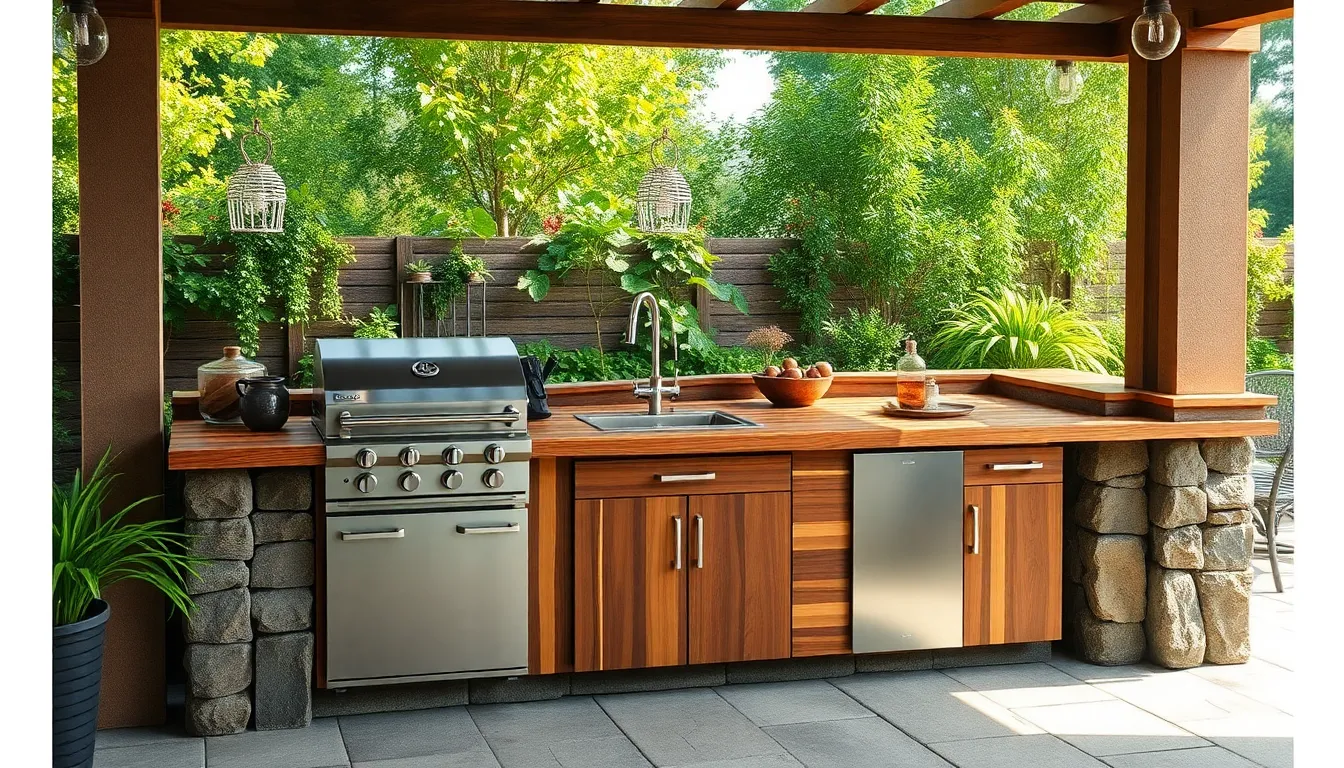
Wood countertops bring unparalleled warmth and natural character to BBQ islands that stone and metal surfaces simply can’t match. These surfaces develop unique charm over time, creating inviting outdoor cooking spaces that feel connected to nature.
Teak and Cedar for Outdoor Durability
Teak stands out as the premium choice for wood countertops in outdoor BBQ islands due to its exceptional resistance to moisture, rot, and insect damage. Natural oils within teak’s dense structure provide built-in protection that helps it age beautifully without warping or cracking, even in harsh weather conditions.
Cedar offers another excellent option for those seeking durability at a more accessible price point. While slightly softer than teak, cedar’s natural resilience and moisture-resistant properties make it highly suitable for outdoor use. Both woods contain natural compounds that repel insects and resist decay, making them smart investments for long-term outdoor kitchen projects.
Weather resistance in these premium woods comes from their tight grain structure and natural preservative oils. Teak can withstand temperature fluctuations and humidity changes that would damage lesser wood species. Cedar’s aromatic compounds not only smell pleasant but also provide additional protection against environmental stressors.
Proper Sealing and Maintenance Methods
Sealing wood countertops with weather-resistant varnishes or marine-grade finishes protects them from moisture, heat, and UV damage that can cause swelling, warping, or discoloration. Without proper sealing, even durable woods like teak and cedar will deteriorate faster than expected in outdoor environments.
Regular maintenance includes reapplying protective finishes and cleaning surfaces to preserve their natural colors and prevent decay. Most wood countertops require finish renewal every 1-2 years depending on exposure levels and local climate conditions.
Cleaning routines should focus on gentle methods that don’t strip protective coatings. Mild soap answers work best for regular maintenance, while specialized wood cleaners can address stubborn stains or discoloration. Sanding and refinishing every few years helps maintain the wood’s original beauty and structural integrity.
Integration with Outdoor Kitchen Design
Wood countertops complement both rustic and modern outdoor kitchen designs when paired thoughtfully with other materials like natural stone, stainless steel appliances, or decorative tile backsplashes. The key lies in balancing wood’s organic warmth with the functional requirements of outdoor cooking.
Positioning wood surfaces away from direct heat sources extends their lifespan while maintaining their aesthetic appeal. Strategic placement around prep areas and serving zones maximizes wood’s visual impact without compromising durability.
Design harmony emerges when wood countertops connect seamlessly with other BBQ island elements through consistent color palettes or complementary textures. Mixing wood with granite or concrete creates ever-changing visual contrasts that enhance the overall outdoor kitchen experience while ensuring each material performs its intended function optimally.
Conclusion
Creating the perfect BBQ island countertop comes down to balancing your exact needs with your design vision. We’ve explored materials ranging from heat-resistant granite to modern stainless steel and each offers unique advantages for your outdoor cooking space.
Your choice should reflect how you’ll use your BBQ island most frequently. Whether you prioritize low maintenance with concrete surfaces or prefer the natural beauty of quartzite the right material will serve you well for years to come.
Remember that proper installation and regular maintenance are key to maximizing your investment. We recommend working with experienced professionals who understand outdoor kitchen requirements and local climate considerations.
Transform your backyard into an impressive entertaining space by selecting a countertop material that matches your cooking style and aesthetic preferences.
Frequently Asked Questions
What is the best countertop material for outdoor BBQ islands?
Granite is often considered the best overall choice due to its exceptional heat resistance (up to 1,200°F), minimal maintenance requirements, and durability. Stainless steel is another excellent option for those wanting a professional kitchen aesthetic with easy maintenance and weather resistance.
How heat-resistant are natural stone countertops for BBQ islands?
Natural stone countertops offer excellent heat resistance. Granite can withstand temperatures up to 1,200°F, while quartzite handles up to 1,000°F. These materials won’t crack or discolor from hot pots, pans, or grilling equipment, making them ideal for outdoor cooking spaces.
Do outdoor countertops require special maintenance?
Yes, most outdoor countertops require specific maintenance. Natural stones like granite, marble, and quartzite need periodic sealing to prevent stains and moisture damage. Stainless steel requires regular cleaning, while wood surfaces need frequent sealing and protective treatments to withstand weather conditions.
Are concrete countertops suitable for outdoor BBQ islands?
Absolutely. Concrete countertops offer excellent durability and modern industrial style. They can be customized with stamps, textures, and colors to mimic natural materials. Polished concrete provides a sleek, easy-to-clean surface that integrates seamlessly with BBQ island layouts and built-in appliances.
What’s the difference between ceramic and porcelain tiles for outdoor use?
Both ceramic and porcelain tiles are heat and moisture resistant, but porcelain is denser and more suitable for harsh weather conditions. Porcelain tiles offer superior durability and freeze-thaw resistance, making them the preferred choice for outdoor BBQ islands in challenging climates.
Can wood countertops be used in outdoor kitchens?
Yes, but they require careful selection and maintenance. Teak is the premium choice due to its natural moisture resistance and durability. Cedar offers a more budget-friendly option. Both require proper sealing and regular maintenance to protect against environmental damage and preserve their appearance.
How do I choose between different countertop materials?
Consider your budget, maintenance preferences, climate, and design style. For low maintenance, choose granite or stainless steel. For customization, consider concrete or tile. For luxury appeal, marble or quartzite work well. Match the material to your cooking habits and local weather conditions.
Are tile countertops durable enough for outdoor BBQ islands?
Yes, tile countertops are exceptionally durable for outdoor use. Porcelain tiles offer the best weather resistance, while natural stone tiles like granite and slate provide excellent heat resistance and slip resistance. Proper installation and sealing ensure long-lasting performance in outdoor environments.

